Here’s a full natural history overview of the Elk / Moose (Alces alces), the largest member of the deer family:
Moose / Elk (Alces alces)
Taxonomy & Classification
- Kingdom: Animalia
- Phylum: Chordata
- Class: Mammalia
- Order: Artiodactyla (Even-toed ungulates)
- Family: Cervidae (Deer)
- Subfamily: Capreolinae (New World deer)
- Genus: Alces
- Species: A. alces
- Common names: Moose (North America), Elk (Eurasia), Eurasian Elk
General Description
- Size: The largest living deer species.
- Height at shoulder: 1.4–2.1 m.
- Length: 2.4–3.2 m.
- Weight: 200–700 kg (bulls much heavier than cows).
- Appearance:
- Long legs, humped shoulders, and a distinctive overhanging upper lip.
- Broad, bulbous nose and a “dewlap” (skin flap) called a bell under the throat.
- Coat: Dark brown to blackish in winter; lighter brown in summer.
- Antlers:
- Males (bulls) grow large, broad, palmate antlers (spanning up to 2 m across).
- Shed annually after the rut and regrown in spring.
- Females (cows) lack antlers.
Behavior & Lifestyle
- Activity: Mostly crepuscular (active at dawn and dusk).
- Social structure: Solitary; cows with calves are the main exception.
- Movement: Despite their size, moose are strong swimmers and can run up to 55 km/h over short distances.
- Communication: Low grunts, bellows (during rut), and scent-marking.
Diet
- Herbivore (browser):
- Feeds on twigs, shoots, and leaves of willows, birches, aspens, and other shrubs.
- Aquatic plants in summer (e.g., pondweed, water lilies)—moose can feed underwater.
- Seasonal diet:
- Summer: Leaves, herbs, aquatic vegetation.
- Winter: Woody browse, especially twigs and bark of deciduous trees.
Life Cycle & Breeding
- Mating season (rut): September–October.
- Courtship: Bulls call loudly and fight by locking antlers to establish dominance.
- Gestation: 230–240 days.
- Calving: May–June, usually 1 calf (twins common in good feeding years).
- Calves: Born reddish-brown, stand within hours, stay with mother up to a year.
- Lifespan: Typically 15–20 years in the wild.
Habitat
- Prefers boreal forests, mixed woodlands, wetlands, and river valleys.
- Requires habitats with abundant shrubs and aquatic vegetation.
- In winter, moves to sheltered forested areas with less snow depth.
Geographic Range
- North America: Alaska, Canada, northern United States (Rockies, Great Lakes, New England).
- Europe & Asia: Scandinavia, Baltic states, Poland, Russia, and across Siberia.
- Fragmented populations occur further south in mountain ranges.
Ecological Role
- Browser pressure: Shapes forest regeneration by heavily feeding on young trees.
- Prey: Adults rarely preyed on (wolves, bears, Siberian tigers may take calves or weakened adults).
- Cultural role: Important in indigenous traditions, folklore, and hunting.
Conservation Status
- IUCN Red List: Least Concern.
- Population trends: Stable globally, though declining in parts of southern range due to habitat loss, climate change, and parasites.
- Threats:
- Vehicle collisions.
- Overhunting (locally).
- Climate-related parasites (e.g., winter ticks, brainworm).
- Conservation measures: Regulated hunting, habitat protection, and reintroduction programs.
Interesting Facts
- Moose are the only deer species adapted to feed extensively on aquatic plants.
- Their nostrils can close underwater while feeding.
- They are excellent swimmers—able to cross large lakes and rivers.
- Despite their size, bulls can be extremely aggressive during the rut.
- The Eurasian name “Elk” can cause confusion, since in North America “elk” refers to Cervus canadensis (wapiti).
Visited 907 times, 6 visit(s) today
Views: 1333
Subscribe to the newsletter:
